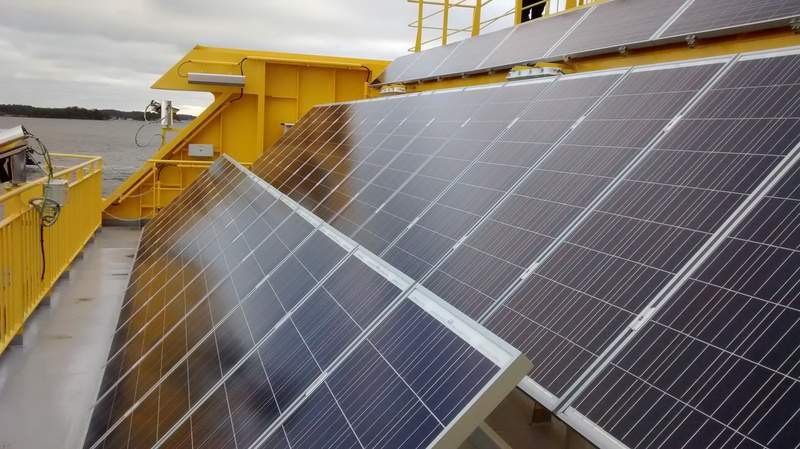
Heavy vibrations, exhaust fumes and loud engines are just a few things you expect when travelling on a ferry. However, from the moment you board the Elektra, you are immediately struck to find these features entirely absent.
Scandinavia is bearing witness to a new generation of clean, vibration-less and near-silent technologies, thanks to Siemens’ partnerships with national ferry operators.
The company was responsible for the technology on the Norwegian vessel MF Ampere, the world’s first full electric car ferry, which began operations in 2015.
This electric-hybrid technology has now moved over to nearby Finland to state-owned operator FinFerries, which carries approximately four million vehicles and ten million passengers a year.
Finland’s first hybrid-electric ferry

FinFerries’ Elektra is Finland’s first hybrid-electric ferry, operating in the Turku Archipelago on the 1.6km route between Parainen and Nauvo around 25 times a day. A charger unit is deployed each time the vessel docks to pick-up and drop-off passengers and vehicles.
Within five and a half minutes, charging is complete and the vessel is ready to perform another 15- minute crossing. This functions as more of a ‘top-up’, with a full charge only taking place once the ferry has docked and finished operations for the day. Electricity for charging comes directly from the grid.
The Elektra has the capacity to travel five nautical miles on one charge. However, the vessel has been specifically designed for the route it operates, where it can mostly run entirely on electric power. As a back-up, the Elektra has three diesel generators installed on-board, which are intended to be deployed to cope with the heavy ice that forms during Finland’s harsh winters.
The vessel is capable of carrying 90 cars and 375 people at a top speed of 11 knots, saving 60% in operating costs compared with similar sized vessels that run solely on fossil fuels. The 98m-long ferry has 160 lithium-ion batteries on-board, with a combined total output of 1MWh. To further boost the Elektra’s green credentials, it is fitted with several solar panels that feed back into its power system.
A vibration-free experience

What’s particularly noticeable about travelling on the Elektra is the complete lack of vibrations and engine noise when running in electric mode. Even in the engine room itself, it’s possible to have a conversation without raising your voice, and be able to clearly hear what the other person is saying.
In the cabin area during the crossing, there were no audible or visual signs to suggest that the ship was even in motion. The technology’s smooth operation even has the potential to make certain cases of seasickness a thing of the past.
The Elektra’s on-board technology has been developed in collaboration with Siemens.
“The Elektra is part of a fleet now numbering four fully electricity propelled ferries run by the shipping company FinFerries, which are equipped with our BlueDrive PlusC propulsion concept,” says Odd Moen, Siemens head of sales for marine and shipbuilding. “This encompasses a power storage system, a warning and observation system and variable-speed propulsion technology for the propellers. The batteries are charged as long as the vessel is docked.”
The system builds on technology developed for industrial offshore vessels, having been proven in adverse operating conditions.
BlueDrive PlusC also features EcoMain technology, which compiles the vessel’s operations data to provide a complete breakdown of its performance and alert users of any areas that require attention. In addition, the system enables performance data to be accessed remotely.
“The technology works and is profitable,” adds Moen.
Construction of the Elektra started in June 2016, with the vessel entering service 12 months later. Despite the technology being in its early stages, there is growing interest from operators seeking to reduce both their carbon footprint and running costs.
“Battery-powered ferries are vital to the achievement of sustainable, efficient and reliable shipping,” says FinFerries CEO Mats Rosin. “We’re proud to have accomplished something of a pioneering achievement with the ferries of our electric fleet thanks to Siemens, and we’re excited about the possibilities afforded by these green technologies.”
Rosin says that there is an advantage in not being the first operator to use this technology.
“It’s a good thing to be second, because you learn the mistakes from the first,” he adds.
Developing clean technologies

The electric operating systems have been pioneered by Siemens as part of its commitment to developing clean technologies. The company has installed hybrid power technologies on other vessels such as fishing boats and the offshore support ship Edda Freya, which is used for cable laying and construction.
Siemens is also developing electric technology for cargo vessels through similar hybrid power systems, although Moen admits that there is some way to go for before these behemoths become fully electric.
“A battery for a cargo vessel to be electrically propelled would need to be almost as big,” he says. “You would need to have another ship to carry it.”
Scandinavia is right on the frontline of climate change, with weather patterns having noticeably shifted even within the last decade. A lack of snow in the thick of winter is no longer unusual, with locals confirming that the chill now arrives a couple of months later than it used to.
What is clear is that there is now both the technology and industry will to make plumes of black smoke billowing from loud engines on industrial vessels a thing of the past, as operators seek to save costs while reducing their carbon emissions.



